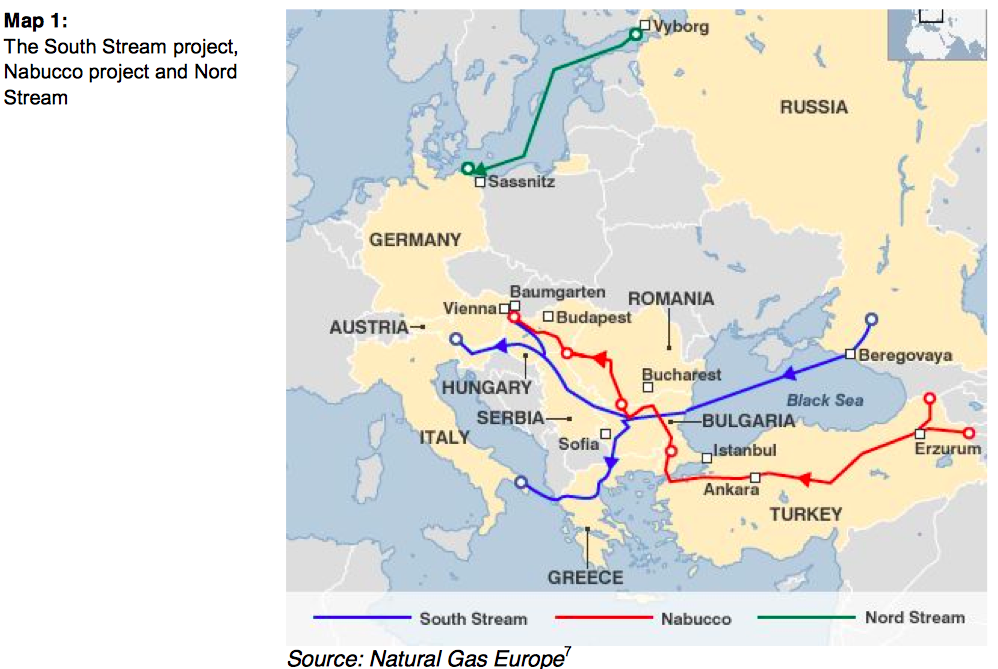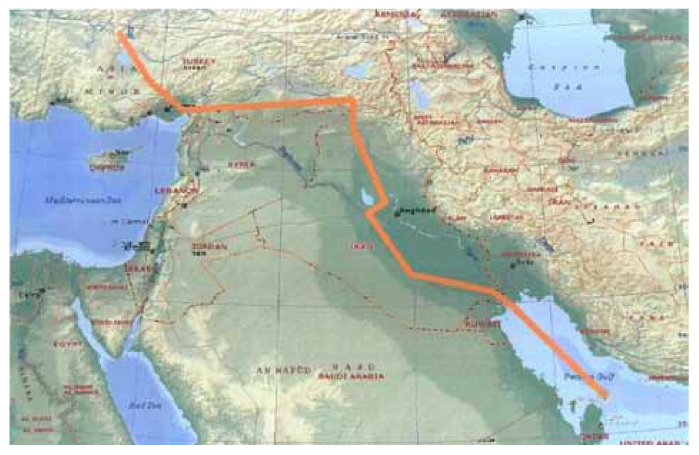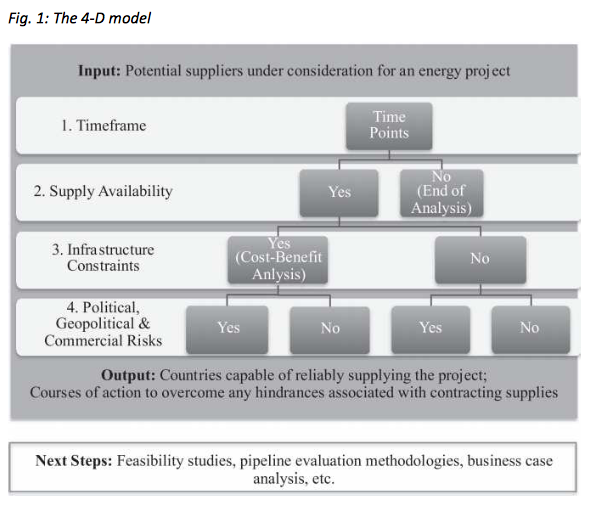THE TRUTH ABOUT THE ORIGINS OF SYRIA’S CIVIL WAR

It is time to put an end to stories that can still be heard about the possible secret origins of Syria’s civil war that plunged it into a bloodbath for more than 5 years - hidden by Western media of course – and should be sought deep down in those souls corrupted by money and vice that you might encounter in abundance under Qatari’s turbans or Texas cowboys’ hats.
Once this said then, it all boils down today to a conspiracy over oil and gas where “big money” is involved and a question of geopolitics over depleting carbon energy resources[1] according to the ultimate avatar of Judeo-Masonic conspiracies which have been agitating neurotic spirits from the beginning of the twentieth century (until the horrors we have come to know in the 40s).
In other words, the 2011 Arab Spring, which affected Syria as well as Tunisia, Bahrain and Egypt, would be reduced to a banal “revenge” of Qatari emirs and Turkish Islamists, supported, of course, by the CIA, and motivated by the lure of profits that escaped them due to the resistance of the “legally elected” president of Syria, Bashar Al-Assad.

“The Pipeline that explains ALL”
(Excellent map by @KarlreMarks)
The story continues to spread, easily understood, and benefiting especially from a “post-truth” hidden by Western leaders and media and that “free” enlightened minds have undertaken the task to reveal to all.
The best way to react would be with disdain and amusement yet when “serious minds” and especially political leaders succumb with disconcerting, and above all, disturbing ease, it is worrying for the future of countries led by such gullible people.
We propose to analyze this story, its evolution over time, and then show that not only the story is false but even dangerous for understanding events in Syria and, on a wider scale, throughout the world.
The Syrian Natural Gas Pipeline Legend and its Different Avatars:
As far back as we can go, this Natural Gas pipeline theory seems to have originated (though we have no certainty about that) in a short article, by Pepe Escobar, an Asia Times correspondent, and author of controversial books on Obama and the USA, published by Al Jazeera on August 6, 2012 and called “Syria’s Pipelineistan War”[2].
The confused and unsubstantiated story was originally intended to explain the origin of the 2011 uprising in Syria by an operation of destabilisation of Turkey against Assad in order to defeat plans for gas pipelines competing with the Nabucco pipeline projects, even though Turkey was included in some of the projects in question.
The Theory becomes even more complicated in order to integrate a Qatar designed pipeline project (the “Arab” project) which would be in conflict in Syria with the Iran-led pipeline. As Assad preferred this latter project to the Qatari one, the CIA and the Gulf Monarchies would then have triggered operations piloted from outside Syria to bring down the Assad regime and replace it with a ‘friendly’ Sunni leader, with the success we know.
The story thus focuses on two rival natural gas pipeline projects, one proposed by Qatar and the other by Iran. As the first one was refused by Damascus who preferred the other, it set off a Turkish-American-Qatari revenge[3] leading to the 2011 demonstrations implying they were neither spontaneous nor of internal origin[4].
Analyzing how true this story is, which is presented as a unique and secret explanation for the origins of civil war in Syria, requires fact checking by noting the different gas pipeline projects, their chronology, and then identify the improbabilities, before checking where this story stands in Assad regime’s propaganda, and finally, to conclude how dangerous this explanation is, as it is not only ineffective but misleading as far as the complexity of Syria’s situation in 2016.
One Pipeline Can Hide Another: Natural Gas Pipeline Projects in the Region in March 2011[5]
It must be remembered that prior to 1999, Syria was the main natural gas producer in the Levant, from huge onshore fields East of Homs and North of Palmyra (most were held by Islamic State on 31 December 2016). This explains why natural gas is an important component of Syrian energy consumption (25.6% in 2009)[6], with natural gas producing 63.5% of electricity consumed in the country[7]. In 2010, Syria was one of the main producers and consumers of natural gas in this Region of Middle-East[8].
Other Levant countries have recently identified important offshore gas fields off Palestine and Cyprus (discovered from 1999[9] onwards and will focus on high potential fields since 2009).
The development of natural gas in the Syrian economy took off slowly in the 1980s, to bear fruit from the years 2000 and on. Despite the gas reserves and investments, production failed to cover the needs of a country in full economic and demographic development, and from 2008 on, natural gas imports were on the increase, mainly from Egypt through the AGP Pipeline[10].
The natural gas requirements of the region, especially in Syria, continued to increase and since 2009 Damascus has been looking for different ways to increase its imports, eventually leading it to enter into talks with Turkey (to transit Azerbaijani gas), Iran, and even Iraq.
As for gas pipeline projects, it is essential to determine the date to establish whether “competing” projects could have played a role in triggering the war in Syria.
The Syrian “Arab Spring” began in March 2011 (the Syrians themselves do not agree on the exact date between 15 and 18 March 2011[11]).
To date, an important gas pipeline in the Levant region is the AGP one linking Egypt and Syria to Israel and Lebanon[12] and two major pipeline projects[13] which are known to be at a standstill at the moment for different reasons:
- the Qatar Project[14]: this project was designed on the basis of a European Commission feasibility study in 2005[15], in order to increase imports from Qatar, shipped previously by LNG tankers. Two routes were considered: one (Plan B - with an inaccurate path) by Saudi Arabia, Kuwait, Iraq to Turkey and the other (Plan A on the map) by Saudi Arabia, Jordan, and Syria to Turkey. The first route is the most economical but requires a stabilization of the situation in Iraq, the second one was planned in 2008 but refused by Syria and Saudi Arabia.

- the Nabucco project (Iran and Transcaucasia): it is an older and more important project, since it dates back to 2002 and has had several versions. It was initially intended to bring gas from Iran to Europe but due to the tension linked to the Iranian nuclear program, it led Europe to reorient its project towards gas from Azerbaijan and Turkmenistan. Once the international consortium was formed[16], talks were conducted regularly until Russia’s competing projects short-circuited its advance and blocked any progress as early as 2010[17].

A pipeline project from Iran, the Islamic Gas Pipeline (IGP)[18] formalized in a tripartite agreement between Iran, Syria and Iraq in July 2011 should be added. Although this occurred after the beginning of the Syrian Revolution, it seems, although not certain, to have been the result of negotiations begun before the Revolution broke out and should be taken into account for the sake of complete transparency.
All these projects have one main objective: to diversify Europe’s gas supply, to break its energy dependency away from Moscow[19], by notably favoring imports from Qatar, or Iranian or Azerbaijani gas fields[20].
It should be noted that beyond this main goal, Syria also had to meet its own natural gas needs. The gas pipeline projects studied will concern not only those transiting the country but also those supplying it.

When it definitely does not fit: dates & chronology
The simple chronology of events shows that nothing can relate the outcome of these various projects - all at a standstill today - with the events that began in Syria in 2011.
Spring 2009: Damascus refused (under Russian pressure[21]) the Qatari project proposed with Turkey’s backing, even despite favorable conditions for Syria, which led to favoring another route via Kuwait and Iraq[22].
June 2009: Azerbaijan granted Russia[23] access to its resources and the South Stream project[24] to the detriment of the Nabucco project which lost much of its feasibility
June 2009: Turkmenistan signed a gas supply agreement with China which eliminated de facto the possibility of supplying the Nabucco project[25]
March 2011: Demonstrations began throughout Syria, violently repressed and which would lead as early as June 2011 to the first armed clashes in Deraa[26], the beginnings of the civil war
July 2011: Iran, Iraq and Syria announced the signing of their agreement for the IGP project[27]
This chronology will include Azerbaijan’s decision in 2013, for its exports to Europe, to dismiss definitively the Nabucco project, which was suspended.
Linking the outbreak of demonstrations in March 2011 with foreign destabilization maneuvers aimed at bringing down Assad’s dictatorship with the twofold objective of undoing Damascus’s refusal to accede to the Qatari project that had been rejected two years earlier and blocking an agreement in July 2011, cannot be taken seriously then from the point of view of dates.
The Improbabilities of Gas Pipelines Explaining the War in Syria
Beyond noting dates which are difficult to challenge, it is essential to analyze the chain of events that led to these three projects, even though not one of them has materialized so far.
First, it should be noted that Iran’s announcement of an agreement in principle on an IPG pipeline project through Iraq and Syria in July 2011 cannot be taken seriously. This project involved building a pipeline in Iraq, a country undergoing a civil war, and in Syria, a country plagued by high instability, and even in areas beyond Baghdad’s control, namely Islamic State and the Kurdish controlled territory.
Besides, beyond the technical feasibility of the IPG project that has never been seriously studied - even in 2016 - the project has no funding as two of the three signatory countries are subject to international financial sanctions making its funding from abroad impossible[28].
Therefore, this project cannot be considered a “rival” to either the Nabucco project or the Qatar project but rather a simple announcement allowing Iran to exert pressure on the international community. It is obvious that none of the signatories seriously believed in this project, where no advance has been seen, even from a strictly legal point of view since 2011.
Finally, it should be added that if this project were to be implemented, it is with Russia above all that Iran would be in competition.
As for the Nabucco project, it is faced with difficulties due to the international context as can be seen when Europe decided to cease participation in the project with Iran. Then Russian maneuvering succeeded in gaining supply sources that had been intended for the project (Azerbaijan), some of which were also strongly engaged towards the East and to China (Turkmenistan).

Nothing in the non-implementation of the Nabucco project can reasonably be attributed to Bashar al-Assad and explain an effort to destabilize his dictatorship.
In theory, the Qatari project would be the ideal motive for destabilising Assad’s regime, but the theory does not hold when facts and details are examined..
According to Syrian sources (no sources from Qatar confirmed it), this project was rejected by Damascus in 2009, two years before protests started. Therefore, there is nothing indicating a link between these two historical events so distant from each other, especially when the latter is a part of dynamics that affected several Arab countries in 2011 in a very different way and far removed from the contingencies of the geopolitics of natural gas.
In actual fact, it should be remembered that the Qatar project had two optional routes:
- Option 1: the shortest (2900 km) and the most economical: Qatar / Bahrain / Saudi Arabia / Kuwait / Iraq / Turkey
• Option 2: the longest and least profitable: Qatar / Bahrain / Saudi Arabia / Jordan / Syria / Turkey
The cost of the project varies according to options between $ 8 and $ 10 billion.
In any case, as it is faced with several major political obstacles, Damascus’s 2008 refusal has little weight.
First of all, the shortest route crosses Iraq from South to North, from Basra (a Shiite area) to Kurdistan, in regions where the situation is particularly unstable and Baghdad’s power is disputed.
This is the only map showing the exact layout of this project in its preferred version as it is more economical:

We found only one map on the exact layout of the route favoured by both Qatar and Turkey and concerns Syria in no way whatsoever.
Then, and this is the main obstacle, whichever route is chosen, the pipeline must pass either through territorial waters or through Saudi territory.
However, Saudi Arabia today is now in direct rivalry with Qatar, and opposes any project that would see an increase in Qatari exports. For example, the Al Khaleej gas pipeline project between Qatar and Kuwait was blocked by Riyadh from 2002 on.
Thus, even if Damascus had accepted the Qatari (and Turkish) project, it would not have been implemented because of the Saudi blockade.
So the argument that by overthrowing Bashar al Assad a project that had been constantly vetoed by Saudi Arabia for several years could have been undone is not valid.
It could be added that the situation of Turkey, which is involved in most of the projects and particularly interested in an extension of the AGP pipeline from Homs to Killis following a formal agreement with Damascus as early as 2000, excludes any destabilization of the Assad regime based on gas pipeline motives[29], without even taking into consideration the Kurdish question.
It is also interesting to note that this theory ignores the reality of the particularly complex decision-making process for investments in oil and gas infrastructure, which places criteria such as technical feasibility, financing and profitability of the pipeline project well ahead of those related to the geopolitical context[30].

Finally, it cannot be ignored that the construction of a gas pipeline, especially a project abandoned as early as 2009, could not even be envisaged due to the current situation in Syria, and in Iraq.
Some of the above details on the various projects, from technical or specialized studies, cannot be found in the “general public” presentation of these projects, notably in Wikipedia records in French or English[31], a sign of the stakes for regime propaganda and its allies, Russia and Iran, behind this story and making it available to as many people as possible..
A “foreign hand”: a recurring theme in Assad’s propaganda.
All dictatorships have a natural tendency to try and dismiss political protests as merely a foreign led destabilizing maneuver.
Yet Assad’s dictatorship, which has lasted for more than 40 years, has taken this fundamental formative disposition of its propaganda a step further: a “true” Syrian would never question the Assad-Makhlouf clan’s domination over the whole country unless he was an agent from abroad.
The story behind the Iranian-Qatari pipelines conflict, dating from 2012, provided a “plausible” motive to an already well-oiled speech at the beginning of the popular protest.
 As early as March 2011, confronted with a general political challenge all over the country and in all communities (including the Alawis, Druze and Christians), Bashar al-Assad saw in this agitation an operation by a foreign enemy[32].
As early as March 2011, confronted with a general political challenge all over the country and in all communities (including the Alawis, Druze and Christians), Bashar al-Assad saw in this agitation an operation by a foreign enemy[32].
However, the scale of the protest could not be the result of a destabilizing maneuver orchestrated by a secret service, however powerful it might be. The demonstrations affected every city in the country, repeating themselves with remarkable consistency, and with slogans intimately linked to domestic issues concerning Syrian society, its aspirations and daily needs.
The longevity of the movement is due both to Syrians’ profound aspirations and regime blunders which mingled violent arbitrary repression and targeted concessions, even causing criticism within its own security force[33].
Admittedly, Syria with its actions in support of terrorists, including jihadists in Iraq, for example, has long been on the list of countries (like North Korea and Iran) considered hostile by the US administration. Even more so, in 2006, the United States openly assumed this hostility, even though it did not exclude ad hoc collaboration in the fight against terrorism, and remains committed to supporting all initiatives to change the regime and put an end to the dictatorship.
The confidential telegrams revealed by Wikileaks are clear on the subject, and indicate the classical positions of a great power anxious to defend its interests[34].
However, this stance, adopted in 2006[35], and subsequently revised by the US administration, was followed up by little effect. There is no established link between these intentions in 2006, subsequently in question, with the events of March 2011.
The mobilization of Syrians was based first and foremost on internal causes and was not manipulated from abroad: an economic crisis linked to a succession of droughts that hit the country from 2006 to 2011[36], and to Bashar’s failed liberalization policy, associated with an enormous population pressure (the population rose from almost 13 million in 1990 to more than 22 million in 2011) with a strong representation of young people (average age of 21.7 years old in 2010 for men and 22.1 for women).
In 2011, the social situation in Syria had been explosive for several years, with an important rural exodus, an increasing religious communitarianism[37], a sharp rise in inequality, and a discrepancy between the expectations of a large youth population and reduced economic integration capabilities. The blunders of a particularly violent repression against young people and even children, such as Hamza al-Khateeb[38] triggered the outbreak of the revolution.
The study of revolutions in history shows that these factors are quite sufficient to explain a political crisis where leaders are challenged. Destabilization operations will have no effect on such cumbersome trends, particularly from the demographic and economic point of view.
There is, therefore, no reason to give credit to regime propaganda, which has not ceased since the beginning, denouncing a foreign conspiracy.
Even more so, the chain of events shows that in reality the protest movement arose in Syria and emanated from Syrians living in their country and not from exiles or outside groups.
Indeed, groups of Syrians living abroad, and taking advantage of the events of the Arab Spring[39], tried several times to mobilize demonstrations hostile to the regime, especially via social networks. These efforts proved complete failures, as at the beginning of February 2011 when a call to protest was launched on Facebook[40] and led to NO demonstration[41].
The foreign plot thesis to explain the war in Syria is simply not serious, at least seen in the framework of a scientific approach. Hence, the question of a hypothetical motive to this plot linked to gas pipeline projects becomes moot.
Conclusion: the danger when you don’t respect the Occam razor rules
When one is confronted with these arguments, some of which do not require much analysis or research[42], it is surprising to see how the pipeline explanation of the war in Syria is still thriving, even though put into perspective, in all serious publications[43].
This false and far-fetched thesis says as much about the cognitive deficiencies of its defenders as it does about the reality of well-documented historical events, and incidentally about the collective disasters to which this period of excessive media coverage is associated with a loss of intellect.
The issues at stake and energy choices, access to scarce oil resources are obviously essential elements to the understanding of geopolitical and historical events.
Evidently there is no question of denying it here.
One just has to remember that the American-Saudi Arabian partnership symbolized by the meeting between Roosevelt and King Ibn Saud on the “Quincy” on February 14, 1944 was a formative element for the entire Middle East[44].

Tensions between Russia and Ukraine can also be evoked over Crimea and for the rest of the country where the link with gas pipeline projects is obvious[45], or tensions in the Caucasus between Russia and Azerbaijan[46].
It is worth noting that Russian meddling, motivated by gas pipeline projects, is ignored by the very ones who denounced an alleged action of the CIA conducted by Qatar in Syria in 2011.
However, it is clear that the stakes of the war in Syria are first of all Syrian, and the regionalization of the conflict will occur later. The interventions of the foreign supporters of the regime date from 2012 and much more important than those backing the rebellion[47].
The danger of spreading the story of gas pipelines as an explanation for the war in Syria lies as much in the ignorance of the origins and reasons for the political protests against the regime as in the denial of foreign interventions without which Bashar al-Assad would no longer be in power.
It denotes a particularly disparaging vision of the Syrian people unable to claim their rights themselves, and without being manipulated by foreign services, for more freedom and a better sharing of the country’s wealth.
Finally, seeking a conspiracy for natural gas or oil in any political crisis is an easy way for leaders in difficulty, to avoid assuming their responsibilities and drawing the consequences of their failures, two essential aspects of a political mandate in a democracy, already too often forgotten by our current leaders.
Article first published in French here
Translated by @dlockyer
Special thanks to her and also for @lmgaveriaux and @Aquila2407
[1] We must remember that the Pipeline and Oil Theory was also used as an explanation for the War in Afghanistan in 2001: Afghanistan: The Pipeline War? http://news.bbc.co.uk/2/hi/south_asia/1626889.stm
[2] http://www.aljazeera.com/indepth/opinion/2012/08/201285133440424621.html
[3] An example of incredible conspiracy delusions : http://yournewswire.com/wikileaks-cables-reveal-usa-signed-death-warrant-for-assad/
[4] The focus of this theory is attributable to a series of articles here: ANSAMED 01/10/2012 http://www.ansamed.info/ansamed/en/news/nations/turkey/2012/10/01/Syria-new-markets-Qatarien-gas-Al-Assad-analyst_7560833.html
[5] One among many references : very good job by Hakim Darbouche, Laura El-Katiri & Bassam Fattouh, East Mediterranean Gas : What Kind of Game Changer ?, NG71, December 2012, Oxford Institute For Energy Studies : https://www.oxfordenergy.org/publications/east-mediterranean-gas-what-kind-of-a-game-changer/
[6] Compared with15% in Israël or 0,6% in Lebanon (datas for 2010)
[7] Compared with 36,6% in Israël and 0% in Lebanon (datas for 2010)
[8] Syria’s natural gas consumption in 2010 was 9.63 Bcm out of a total of 14 in the entire Levant’s zone (Cyprus – Israel – Lebanon – Syria) – for Syria, 8,94 Bcm from local production and 0,7 Bcm imported.
[9] “Noa” was the first offshore natural gas field discovered in Israel in 1999, followed by many others in waters between Palestine and Cyprus in 2000.
[10] Arab Gazoduc Pipeline (AGP), a natural gas pipeline from Egypt to Western Syria on a South-North axis: from Deraa to Homs via Damascus
[11] 15th March 2011 is the beginning of the demonstrations in Deraa after several young boys were arrested on 13th March; 18th March 2011 sees the first “Friday March” all over the country, called “the Friday of Dignity” which was violently repressed by Police and security forces, with the first 4 deaths and hundreds of civilians arrested.
[12] The AGP Pipeline is frequently targeted by ISIS in the Sinaï and has ceased regular production regularly since 2011
[13] Turkey has concerns in many different natural gas pipeline projects but we have only written about projects with links concerning the origin of Syria’s war in 2011.
[14] Is the Qatar-Iraq-Turkey-Europe Natural Gas Pipeline Project Feasible ? Report Nr. 23 – January 2011, ORSAM – Ankara 2011
[15] This project is led by the Qatar Petroleum and Exxon-Mobile East Marketing Limited Company.
[16] The International consortium is a complex system: 5 different national companies under the Nabucco International Company.
[17] Quelles perspectives pour Nabucco et South Stream?, Report for the French Energy Council, Under Zaki Laïdi, IEP Paris – July 2010
http://www.wec-france.org/DocumentsPDF/RECHERCHE/Contrat56_Rapportfinal.pdf
[18] Called “Friendship pipeline” in some sources
[19] In 2011, there were three major countries with natural gas reserves: Russia (1st), Iran (2nd) and Qatar (3rd)
[20] For natural gas issues, Iran with its Fars gas fields is clearly a rival with Qatar and Russia and cannot be considered a reliable sustainable ally for the latest.
[21] The refusal was officially motivated by the objective of preserving the partnerships between Syria and Russia, especially Russian interests : https://www.rt.com/op-edge/syria-russia-war-oil-528/
[22] http://www.thenational.ae/business/energy/qatar-seeks-gas-pipeline-to-turkey#full
[23] agreement signed with Gazprom the 25th of june 2009.
[24] The South Stream gas pipeline project ceased in December 2014 and replaced by the Turkish Stream, a Russian-Turkish project in common.
[25] China, Turkmenistan seal long-term energy deal , AP 25 juin 2009, https://www.highbeam.com/doc/1A1-D991I3P80.html
[26] The first clashes in Deraa didn’t involve foreign fighters but Syrian army deserters who defected in whole units, refusing to repress peaceful demonstrations in Deraa.
[27] The exact date of the July agreement is not certain but some Russian sources gave another date opportunely advanced to March 2011, which is wrong : https://www.rt.com/op-edge/syria-russia-war-oil-528/
[28] ibid. Hakim Darbouche, Laura El-Katiri & Bassam Fattouh, East Mediterranean Gas : What Kind of Game Changer ? p. 17
[29] On Turkish Strategy on Natural Gas in 2011 : Ahmet K. Han, Turkey’s Energy Strategy and the Middle East: Between a Rock and a Hard Place, in Turkish Studies, 12:4, 2011
[30] http://www.jacobs-university.de/sites/default/files/downloads/decision-making_for_supplying_energy_projects_a_four-dimensional_model.pdf
[31] Notice Wikipedia in English on Qatari’s project : https://en.wikipedia.org/wiki/Qatar-Turkey_pipeline and on Iranian’s project : https://en.wikipedia.org/wiki/Iran-Iraq-Syria_pipeline
[32] 30th march 2011 Speech: https://www.theguardian.com/world/2011/mar/30/syrian-protests-assad-blames-conspirators
[33] http://mobile.lemonde.fr/syrie/article/2016/12/01/le-chef-du-renseignement-syrien-regrette-un-manque-de-fermete-au-debut-du-soulevement_5041756_1618247.html?xtref=https://www.google.fr/
[34] The problem is the same people who denounce US or CIA interventions as unacceptable find Russia’s attitude in similar circumstances totally acceptable.
[35] The mostly frequently quoted text is from december 2006 : https://wikileaks.org/plusd/cables/06DAMASCUS5399_a.html
[36] The water situation in Syria began deteriorating from the end of the 90s. 5 consecutive years of drought followed from 2005 when Syria was in a very weakened situation.
[37] Religious communautarism in Syria can be explained by regime choices, Iran’s influences, and also the loss of traditional structures after the rural exodus as a consequence of the water and economic crisis.
[38] https://en.wikipedia.org/wiki/Death_of_Hamza_Ali_Al-Khateeb
[39] The Arab Spring began in December 2010 in Tunisia and January 2011 in Egypt
[40] for example : http://www.france24.com/fr/20110204-syrie-facebook-mobilisation-manifestation-appel-calme-damas and http://www.rtl.be/info/monde/international/en-syrie-un-appel-a-manifester-contre-la-monocratie-pas-suivi-212868.aspx and : https://www.opendemocracy.net/arab-awakening/hamzeh-moustafa/social-networks-in-syria-between-mediation-and-mobilisation
[41] Generally speaking, unlike others Arab Springs, Internet and social networks – closely monitored by Security services and not so widespread – was less important at the start of the Syrian uprising of 2011: http://ijoc.org/index.php/ijoc/article/viewFile/3527/1436 and http://www.arabmediasociety.com/articles/downloads/20120407120519_Khamis_Gold_Vaughn.pdf
[42] Numerous articles debunked this pipeline theory, unfortunately without gaining the same audience as those who propagated it: http://www.thenational.ae/business/energy/robin-mills-syrias-gas-pipeline-theory-is-a-low-budget-drama ; http://www.lecommercedulevant.com/economie/petrole-et-gaz-liban/le-conflit-syrien-serait-il-lie-des-projets-de-gazoducs-regionaux/2349 ; http://www.truth-out.org/news/item/37685-the-war-against-the-assad-regime-is-not-a-pipeline-war
[43] for example the excellent french work of David Rigoulet-Roze “La variable énergétique dans la crise syrienne - La question stratégique du contrôle d’un futur gazoduc méditerranéen” in Confluences Méditerranée, 2014/4, N° 91, pp. 95-106 : http://www.cairn.info/revue-confluences-mediterranee-2014-4-page-95.htm
[44] Even if historians know in reality that the oil question had already been settled between the Saudi Kingdom and the USA before this meeting, where the main debate was on the Palestine issue : http://orientxxi.info/magazine/la-legende-du-pacte-du-quincy,1213
[45] for example : Pasquale DE MICCO, IN-DEPTH ANALYSIS : Changing pipelines, shifting strategies: Gas in south-eastern Europe, and the implications for Ukraine, Policy Department, Directorate-General for External Policies, UE, 2015 :
http://www.europarl.europa.eu/RegData/etudes/IDAN/2015/549053/EXPO_IDA(2015)549053_EN.pdf
[46] http://www.laender-analysen.de/russland/rad/pdf/Russian_Analytical_Digest_56.pdf
[47] Concerning the unconditional russian backing of Assad since 2011 : “La Russie face aux révoltes libyenne et syrienne – des enjeux jugés majeurs, une politique défensive” de Anne de Tinguy, in LES ONDES DE CHOC DES RÉVOLUTIONS ARABES, Presses de l’IFOP – 2014, Chapitres 4 pp. 85-103 : http://books.openedition.org/ifpo/6930?lang=fr





Merci. Beau travail.